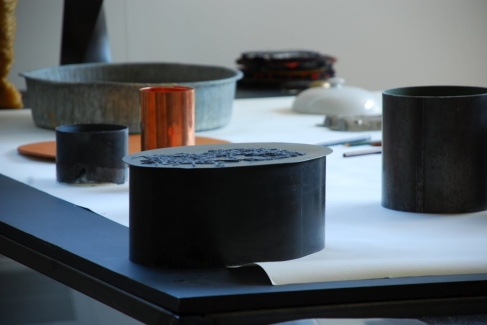Dear Scott,
sorry for the delay in giving you our reactions! Delivery of the projects to Crusinallo proved to be as difficult as it probably was in the ‘50s, but at the end we are happy with the results.
A) THE SELECTION OF THE PROJECTS:
We have made a selection of the projects that we believe can be suitable for the production. I need to underline that at this stage we need some more work directly from the designers, in terms of making themselves more precise prototypes and of taking care of the details and of the questions we ask below. But there are good chances that the majority of the projects of this list will go to production and to official presentation.
Here are our comments, divided by typology:
1. BANANA HOLDER (John Truex)
I like the sculptural approach. Take care of the balance of the object with the bananas on. We will find the way to dismantle it for easy delivery (screw or something other). Please do a good prototype!
2. BANANA HOLDER (Patrick Gavin):
Another sculptural approach I like. Here too the possibility to dismantle would make easier the delivery: but I feel that the technical solution should not be visible (if we do not find a good solution, then preferable to have it in one piece). Please do a good prototype!
3. BANANA HOLDER (Scott Klinker):
Very practical! At the moment to me it looks a bit poor, maybe too simple (but this may be its character). Please do a good prototype!
4. CAKE STAND “V2” (John Truex):
Another good typology!
I would regret if it would miss in the list of the Cranbrook products… But at the present stage there is still something to be improved, we hope the designer will find the improvements:
– maybe too high? (this critic comes from Alessi USA);
– stability is ok ? (should we increase the base size?);
– any knob on the dome (for easy handling)?
Please do a good prototype!
5. PATTERNED DISH FORMS (Scott Klinker)
Yes, we can make a little family of different patterns using the same basic form of the body. Please do some good prototypes!
6. “VTRAY” FRUIT BASKET (Adam Shirley)
The “Vtray” Fruit Basket is the variant that we prefer within the family. Simple, practical, a bit shakerian (that is not bad) in its austerity. Please round the corners. Please do a good prototype!
7. MEASURING CUPS (Suzanne Beautyman)
We would love to add this typology to the list of the products! But we still need from the designer some more explanations about her way to deal with the different measures. Ideally, it would be asked to Alessi to have both American and European indications: can you please send us some more comments. We leave to you to chose between the different design options: listen I would not exclude the simpler version “Bird’s eye, all in stainless steel: it will then ask for a brilliant graphic of the signs printed or punched. Please do a good prototype!
8. “BRANCH”, “LOG” OR “RING” TRIVET (John Truex)
I personally like a lot these projects. I like their sculptural sense. I would go for either the “Branch” or the “Log”, leaving the choice to the author. Please do a good prototype!
9. CONTAINER (VASE) o2 (Adam Shirley)
We identify it as a Vase for flowers. Need your indications about the colour(s) and (if you have a preference) the way of colouring it. Please do a good prototype!
10. TABLETABLE (Patrick Gavin)
The typology is unclear and the price will be high. But the design is good, maybe there is a chance… Please do a good prototype!
11. STRETCH (PUSH) SERIES (Seth Papac)
We have only a few images, and no prototypes, so we are not able to evaluate this project! Looks like Bowls and Serving spoons. And it has some intriguing sides. Can you send more infos and prototypes?
B) THE PRESENTATION:
The time of the presentation will mainly depend from the reactions of the designers. We usually start the presentation when all the projects are ready, or close to be ready, with production.
We may imagine 2011 as reachable.
Then, about the way to organize presentation, we think to organize a kind of -small but precise- travelling exhibition through some Museums or even some Alessi showrooms around the world. Maybe starting with USA. And we have some questions for you:
b) Is Cranbrook willing to design a (easy to assemble and disassemble and move) layout?
bb) Do you want to do have the first step with an official first presentation in Cranbrook?
bbb) In order to make the exhibition as interesting as possible, we could show also some of the projects that are not going to be produced, if the quality of the prototypes if good?
Scott, let me know your reaction asap, in order to go on with the development.
And, I take this occasion for tanking you, your colleagues and all the boys and girls of the workshop. It was a nice experience, now let’s see the production results.
Ciao,
Alberto 11/07/2010























































































































































You must be logged in to post a comment.